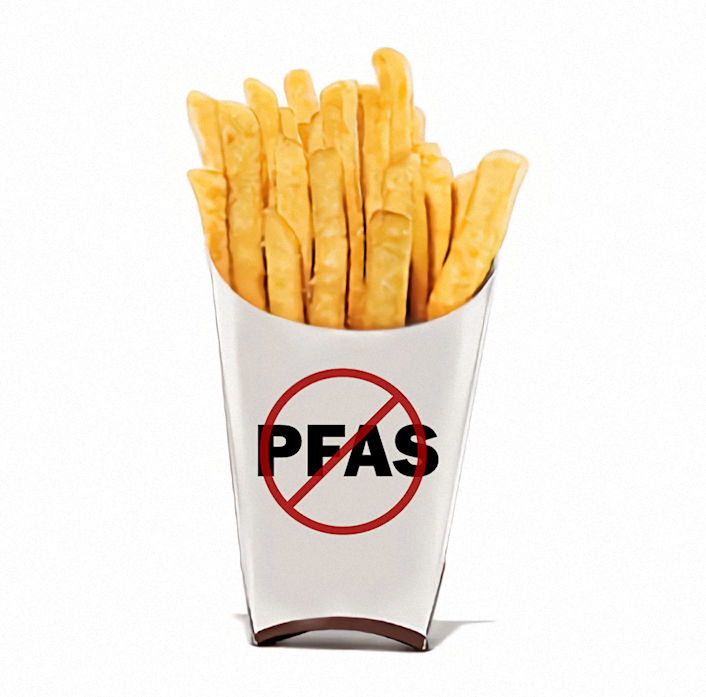
American Chemical Society | Industry | Industry Matters Newsletter | Good Luck With That!
Good Luck With That!
Industry Matters Newsletter 14 April 2022
Good luck with that! was my thought when I saw fifteenth seed St. Peter's matched against perennial power Kentucky in the 2022 NCAA Men's Basketball Tournament. They surprised me and beat Kentucky. Good luck with that! is what I thought when I saw they were up against 30-2 Murray State, and again when confronting #1 Purdue. They surprised me and won those games too.
Good luck with that! is what I thought when reading Burger King is eliminating PFASfrom their packaging.

"Burger King announces global ban of toxic 'forever chemicals' in food packaging" caught my attention. Reporting indicated an elimination of PFAS in food packaging by 2025. PFAS is added at around 1% to paper to make it grease and water resistant. Some of that paper is recycled. Elimination of a ubiquitous material, one that is poorly defined, struck me as unlikely.
The ability to find something depends on how hard you look. Just last week, Consumer Reports released a report after looking hard at fast food packaging. The conclusion was "'forever chemicals' [are] in bowls, bags, plates, and wrappers, even from some companies that say they've phased them out." Some of the PFAS addition was inadvertent, not added on purpose. Particularly high levels found in some packaging was blamed on PFAS being "so common in the environment, it's almost impossible to eliminate them entirely." Ending purposeful addition of PFAS, what Burger King is promising, may be all that can be done. As easy as that sounds, it requires being able to define PFAS.
PFAS is short for per- and polyfluorinated alkyl substances. That's confusing to me, and I'm a chemist. It is clear fluorine is required. One would be mono-, two di-. Poly is more than two. Wait, naphthalene, with only two rings, is the smallest polycyclic aromatic. Poly must mean more than one. It is, at least in the eyes of the EPA and CDC. So PFAS contain more than one, maybe more than two, fluorines.
Alkyl. Something about the molecule must be alkyl to be PFAS. Alkyl could mean that there is nothing but alkyl carbons or that the fluorines are only attached to saturated carbons. I would have guessed hexafluorobenzene and tetrafluoroethylene would be PFAS, but not having an alkyl group excludes them.
Thankfully, there is Reconciling Terminology of the Universe of Per- and Polyfluoroalkyl Substances. It is not for the faint of heart. It is 34 pages of impenetrable prose and there is no simple answer. Determining whether something is PFAS requires a flow chart. Look for either a trifluorinated methyl group or a difluorinated methylene group. If you find either, it is likely a PFAS. The new definition is intended to be an improvement over list-based determination. The report describes how tetrafluoroethylene is not a PFAS, but hexafluoropropylene is. PFAS must have a fluorinated saturated aliphatic group. 2,2-diflurobutane is a PFAS, 2,3-difluorobutane isn't. Fluorinated aromatic rings aren't. They won't be PFAS unless they have a fluorinated alkyl side chain.
My head hurts.
There are thousands and thousands of compounds meeting the PFAS "definition" and many extensively fluorinated compounds that don't. Consumer Reports recognized they couldn't screen for all possible fluorinated compounds. They took a shortcut, looking only for fluorine content. It is a flawed method when the molecular structure is such a big part of what determines whether something is a PFAS.
College organic taught me, incorrectly, that C-F bonds were benign, inert, because they are not found in nature. Putting a fluorine on a biologically active, but rapidly degraded structure, was a way to make drugs and ag chemicals.
The most prescribed drug of all time, Lipitor, is fluorinated. So are Prozac, the new COVID fighter Pavloxid, Flonase, Crestor, and Cipro. A recent study of 360 approved fluorinated drugs found 120 of them were PFAS by the new OECD criteria. Worrisome, only five are by EPA criteria. Six of the seven drugs I listed, if tested as they are administered, would test well above 100 ppm total fluorine, Consumer Reports' level of concern. All are above the 20 ppm Consumer Reports favors as a safe limit. Of the seven, only Pavloxid and Prozac meet the newer PFAS definition. It is not just drugs. 70% of the new agrochemicals approved in the last five years are fluorinated.
I began to believe in St. Peter's. At the start of the game with North Carolina, I was no longer thinking good luck with that!. I thought St. Peter's had a chance. North Carolina easily won the game. My optimism was clearly misplaced. I hope my pessimism on PFAS is also misplaced. Some applications will certainly be reined in. The on-purpose addition of compounds clearly identified as problematic will stop, as Burger King is doing. In a world where the definition of PFAS is elusive, where we willingly swallow and spray PFAS, where PFAS are already found far and wide, the headline that caught my attention is wrong. We won't be eliminating "forever chemicals."